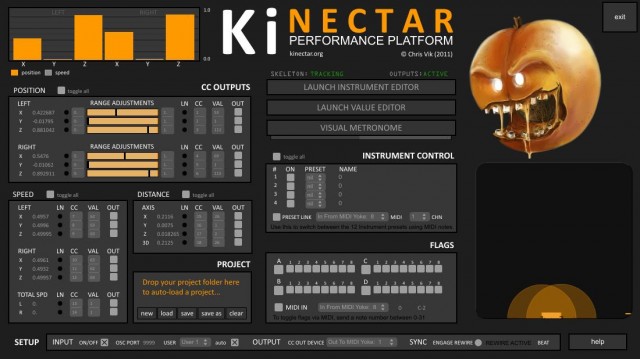It started as some compelling demos or proof of concept, but it’s plenty real now: the tools for translating movement, gesture, and dance from the body to interactive music march forward. Empowered by Microsoft’s Kinect and an artist-friendly toolchain, even a single, clever developer can do a lot. Sound designer, music producer, and Max/MSP developer Chris Vik of Melbourne has been one of those busy early pioneers, with an incredible tool called Kinectar.
So, the tech is cool and shiny and impressive: what about the actual music? And, even more importantly, what if all the hand waving and moving about could be meaningful? That’s the next step. For his part, Chris is teaming up with a dancer and choreographer to combine his compositional ideas with someone who knows how to move. The Dubstep-y demos (all below) are impressive, true, but the early tests of the work with the choreographer are simply beautiful, and demonstrate that wobble bass isn’t the limit of what this can do. They also turn the arbitrary arm-waggling into a part of the art.
And as for you: the software’s alpha, but you can fire up your copy of software like Ableton Live and grab this software for Mac or Windows and try it yourself. So if you don’t like the results – be the gesture-controlled basslines too wobbly, be they not wobbly enough – you can put your music, and your movement, where your mouth is.
At top, Chris shows off an early test of the dance collab. (There’s more to come.) Below, a tutorial that shows how this works with Ableton. And read on for more from Chris on what the work with the dancer is about, and what the tool can do.
Chris writes:
Since April 2011 I’ve been working solidly with the Microsoft Kinect, developing my software, Kinectar, to enable its use as a MIDI controller for performing music live. I’ve done a number of performances around Australia since I started the project, however, it’s safe to say that, although I would consider myself an electronic musician, I’m certainly no dancer. Enter, Paul…
Dancer, Paul Walker and I have joined forces to bring the Kinect controlled music concept into the world of contemporary dance. Recently we obtained a residency at PACT theatre (centre for emerging artists), where we spent the week developing different ways of implementing my Kinect music control system in a dance context.
My system is developed in Max and uses OpenNI drivers, OSCeleton and Ableton Live.
CDM will check back in with Chris soon, because:
I’ve got some more videos to release over the coming weeks from a range of my different Kinect music performance applications, including controlling/conducting the Melbourne Town Hall Organ and a 100+ speaker Kinect-controlled diffusion performance. I’ll keep you posted when they’re released!
More on the software:
Kinectar Performance Platform is a toolkit developed by music producer Chris Vik to allow the use of Microsoft’s Kinect motion tracking sensor in computer-based music. The software is designed for electronic musicians to expand the way they control their music in a futuristic and extremely expressive way, using only the waving of hands and a small amount of creativity. It can be used to control the simplest of parameters like a filter or LFO, play notes and chords on a sampler or synthesizer, or be programmed to control an entire live-set through nothing more than gesture.
Key Features:
Movement Tracking UI allows manipulation of the Kinect’s human tracking capabilities, displaying all relevant data extracted from the hands location in 3d-space
Instrument Builder lets the user build virtual ‘instruments’ by outputting MIDI notes in three modes:
- Static – Produces a single note value. Useful for drum triggers, turning on/off effects within a DAW or feed that trigger into Kinectar to switch between presets using your gesture
- Solo – Do sweeping solos by selecting from over 40 musical scale presets or click the notes on the UI to make your own
- Chord – Create a progression of up to 8 chords per preset to play live
Global Flags lets you turn on/off Kinectar’s instruments using a MIDI note sent from your DAW, external MIDI controller or Kinectar itself
MIDI Preset Control lets you switch between Kinectar’s presets and instruments using a single MIDI note
Value Editor enables many more MIDI/OSC outputs, for controlling device values
Visual Metronome popout window sits on top of all programs to make it easy to see if you’re in-time when the music gets messy
It’s labeled “rough alpha,” so don’t expect a finished tool here, but you can go download it and give it a try (or learn more about what’s possible):
And now, the obligatory (but quite awesome, Chris) Dubstep demo videos:
